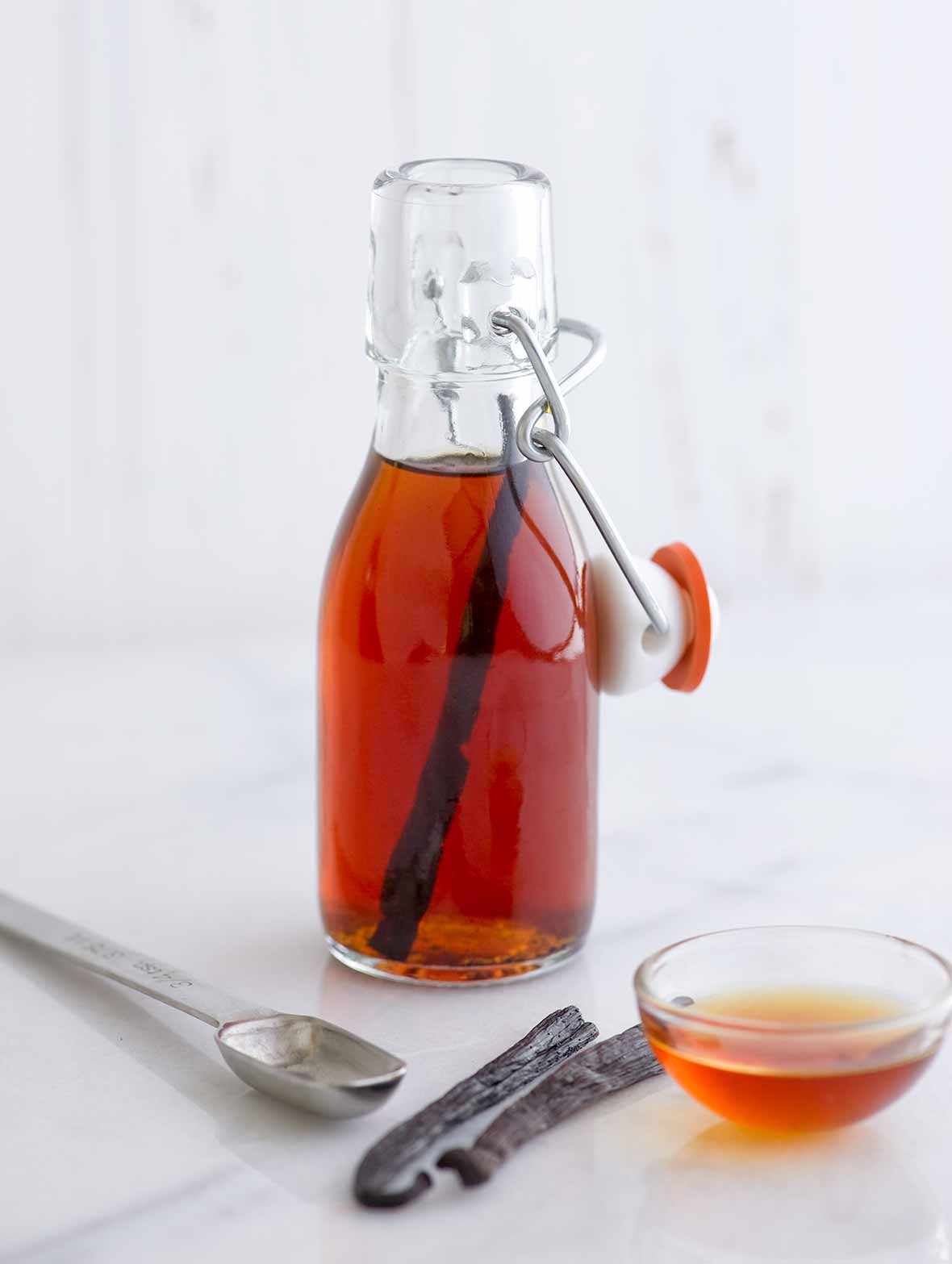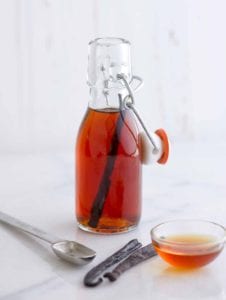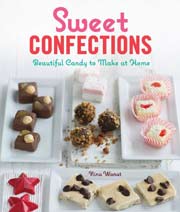
Knowing how to make homemade vanilla extract isn’t so much a talent as it is a simple necessity if you’re a home baker. Whereas most homemade vanilla extracts draw on either brandy or vodka to soak the vanilla beans, this draws on both for an unparalleled measure of complexity—which may initially be mistaken for boozy intensity if you happen to take a whiff too early in the extract’s existence. Rest assured, the booziness will mellow with time and, consequently, the vanilla notes will slowly but surely become more prominent. Trust us. The only trick to this little DIY project is that patience isn’t just a virtue, it’s a vital component. If you’re gifting bottles of the extract before its time is nigh, jot down a “Do not open until [INSERT A DATE THREE MONTHS HENCE]” note on a tag and attach it to the jar or write it on a sticker and affix it to the bottle. Trust us. It’ll build the anticipation.–Renee Schettler Rossi
How long will homemade vanilla extract keep?
Homemade vanilla extract will last indefinitely when kept tightly covered at room temperature.

How To Make Homemade Vanilla Extract
Ingredients
- 1 2/3 cups brandy
- 1 2/3 cups vodka
- 5 vanilla beans, preferably Tahitian or Bourbon, split and seeds scraped
- 3 ounces vanilla extract, preferably Tahitian or Bourbon (optional)
Instructions
- In a 1-quart glass jar, combine the brandy, vodka, vanilla pods and seeds, and vanilla extract, if using. Place the lid on the jar and let the mixture sit in a cool, dark place for at least 3 months. [Editor's Note: The optional vanilla extract boosts the flavor quickly, but it’s by no means necessary. Another way to intensify the vanilla flavor is to save vanilla pods whose seeds you've scraped for another recipe and occasionally toss them in the jar.]
- If gifting, decant the extract into small bottles and screw on the lid or insert a cork or find some other way to tightly seal the bottle. It will last indefinitely at room temperature.

Nutrition
Nutrition information is automatically calculated, so should only be used as an approximation.
Recipe Testers’ Reviews
I made this homemade vanilla extract recipe a year ago and finally pulled it out from the back of the pantry shelf. I will never bother buying vanilla extract again. This had such a lovely, deep, almost intimate flavor. Has anyone tried adding a little bit of brandy or bourbon to the bottle each time you use a bit? Or do you need to use the entire contents, and then make another batch?
I’ve actually been given homemade vanilla extract as a gift from a friend, and was so happy to receive it. This recipe gives me the opportunity to pass on the goodness.
For the brandy, I used a Cognac recommended by my local liquor store and Absolut Vanilla vodka (remember, I’m a Swede!) and my vanilla beans were labeled Madagascar Bourbon. The combination of vanilla vodka and vanilla beans gave me the power of double vanilla, without going the optional route that I’d consider cheating (adding premade vanilla extract to my homemade vanilla extract). I’d rather allow the time than boost the flavor quickly.
A word of caution, however, if you want to use vanilla vodka—again, at the recommendation of my local liquor store—cheap vanilla vodka won’t be made from real vanilla, and the taste of the final extract will reflect this. Only use a higher-end flavored vodka if you want the double-powered effect!
Although the recipe states that it needs to sit for 3 months, it’s certainly usable right away, although I’m going to let mine sit longer. Ultimately, I may continue to use it without decanting, so it continues to grow stronger, unless of course I decide to share some for my own holiday gifts this year. I’d never scale this easy recipe down to anything less than the quart it so successfully makes!
Who knew it could be this easy to make homemade vanilla extract?
I made several jars to see if there were any differences in taste according to the ingredients. I did two according to the recipe—one with the addition of the vanilla extract and one without. I also did one with just brandy and one with just vodka. I did buy good-quality vanilla beans to make this with. I noticed that both smelled more of alcohol than the organic vanilla extract from the store. The original recipe smelled and tasted as good as vanilla from the store. The addition of vanilla extract didn’t seem to add anything so I’d leave it out in the future. The one made with just vodka was sharp both in smell and taste, so I don’t know if that’d carry over in taste when used. The one made with just brandy was very smooth and as good as the one with the 2 liquors.
Since I know how to make homemade vanilla extract, I’ll do this recipe again, as I like a set-and-forget recipe, especially when the results are this good.













I have been making vanilla extract for years. I never use vodka at all, because I find that it gives the extract a rough edge, particularly when using vodka distilled from grain (a bit less so with vodka distilled from potato, such as Luksosowa, a Polish brand).
Instead of vodka, I use white rum, which I find much more smooth, and imparts an ever-so-slight sweetness. You need not go high end in your choices. I find that I do quite well with the lesser known Caribbean imports.
Thanks, Steve. We have another reader trying out a rum version as well as a bourbon version, and both are coming along very nicely. Definitely seems to be a winning variation!
I’ve been making my own for a few years now. Recently I’ve seen some articles from sources including America’s Test Kitchen that indicate you can speed up the process by incubating your vanilla in a hot pot or a sous vide bath.
Personally, I’ve used a simple good quality vodka for the extraction. Though many say you can use cheap stuff I’m reluctant to go there if it’s the principle ingredient. …especially since Costco sells what amounts to a vat of what’s reputed to be Grey Goose for about $30.
At the moment I’m extracting some in spiced rum and I must say, tho it has months to go, it certainly has a promising aroma.
Rainey, you have our attention! Spiced rum . . . we can’t wait to hear how that turns out.
It will be months before I actually get to try it but I’m looking forward to it!
I’m also extracting some in bourbon since so many online seem to choose that as their alcohol alternative. I wonder if they’re confusing the fact that beans from Madagascar are also called Bourbon beans after the growing region in Madagascar because the whiskey, in my opinion, is far too assertive and overwhelms the aroma of the beans and pods. It may one day make a more interesting drink but I doubt I’ll ever bake with this one.
I’m very curious to hear how both of them turn out, Rainey. Do keep us posted!
I’ve completely revised my opinion of the bourbon (liquor) vanilla (made with Madagascar Bourbon beans) after a month of aging. The bourbon itself has mellowed considerably and the vanilla aroma has taken its place as the dominant essence. It’s still young — I intend to let it have at least a full year — but now I see its promise and fully expect to be able to bake with it in time.
Meanwhile, both the vodka and spiced rum versions continue to mature and smell wonderful. And, happily, I have a generous supply of vodka infused vanilla from previous years to work with for the coming year.
As for using the ATK method of incubating the extraction in a sous vide bath, it may or may not have speeded anything up. It’s still taken this past month for the vanilla flavor to have asserted itself.
Finally, in the pic below the vodka (left), rum (center) and bourbon (right) all cost about the same thing. Holy moley that Costco vodka is a bargain!
Thank you, Rainey. This information is incredibly helpful. Do keep us posted on the final results!
Two months in the vanillas are useable but not as mature and full flavored as they will be with additional time.
The spiced rum vanilla is the clear winner by a long shot. The aromas are complementary and deeper than the vodka extracted version. The bourbon whiskey variety is still heavy with the aroma of the bourbon and it continues to want to assert itself over the beans. Maybe all that additional flavor would be a plus for some folks but it’s not my preference.
Spiced rum will be my alcohol of choice from now on.
Thanks for the update, Rainey. So interesting how the choice of alcohol affects the final outcome.
I made another 1.750 liters last night — spiced rum with Madagascar beans — because it’s time to start giving the January batch away. It smells sooo heavenly it pains me to let it go.
I did a bottle at 135˚ for 12 hours with the immersion circulator. This morning it already smells like the equivalent of a month of incubation.
That’s amazing, Rainey. You’re going to have some very appreciative friends!
I made 4 types of extract. One with Smirnoff vodka, one with Sailor Jerry’s spiced rum, one with Paul Masson Brandy and one with Jim Beam bourbon. After one year, I found the bourbon revolting and i took the beans from those bottles and put them in the other 3 kinds and poured the whole lot of bourbon straight down the sink. Almost a liter and a half of it too! In my opinion, I find extract made from Brandy to be very good smelling. I never actually used it yet. I would recommend never using any liquor that you would not drink straight. Too many cheap vodkas that burn ALL the way DOWN.
Thanks, jay. Appreciate you sharing your experience with us.
Do you recommend a certain brand for the brandy and vodka? Does it matter if it is expensive or cheap? I would like to make this and I have no idea what to buy. Thank you.
Shirley, any kind is fine. I usually buy a cheap bottle from Costco for this.
Thank you!
U bet!
If using vodka, I would go with a Polish brand called Luksosowa, which is made from potatoes. It does not have the rough edge that I find in vodkas made from grain. It is very reasonable in price, unlike the other, more heavily advertised Polish brands. (I still recommend white rum, instead of vodka.)
If going with colored spirits (brandy or whiskey, for instance), I would go with the lighter colored ones. Otherwise, you might find the flavor of the spirit competing with the flavor of the vanilla. (If that’s what you want, that’s fine. Just know what you are getting yourself into.)
Thanks, Steve. That’s exceptionally helpful information.